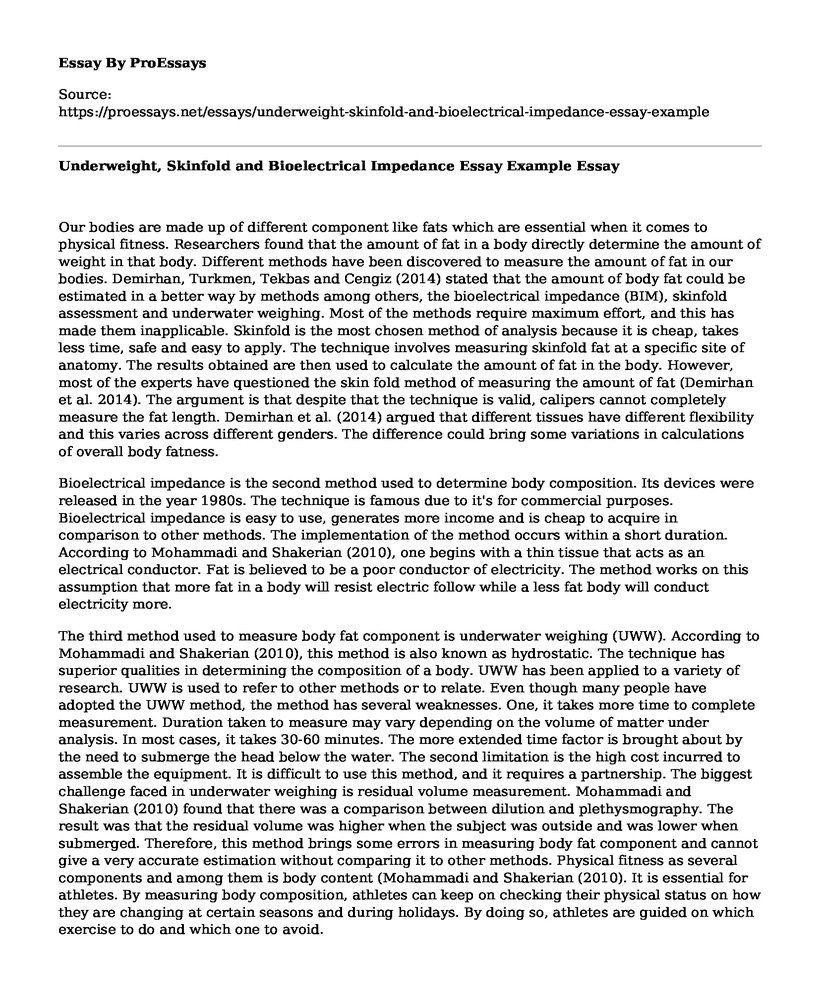Our bodies are made up of different component like fats which are essential when it comes to physical fitness. Researchers found that the amount of fat in a body directly determine the amount of weight in that body. Different methods have been discovered to measure the amount of fat in our bodies. Demirhan, Turkmen, Tekbas and Cengiz (2014) stated that the amount of body fat could be estimated in a better way by methods among others, the bioelectrical impedance (BIM), skinfold assessment and underwater weighing. Most of the methods require maximum effort, and this has made them inapplicable. Skinfold is the most chosen method of analysis because it is cheap, takes less time, safe and easy to apply. The technique involves measuring skinfold fat at a specific site of anatomy. The results obtained are then used to calculate the amount of fat in the body. However, most of the experts have questioned the skin fold method of measuring the amount of fat (Demirhan et al. 2014). The argument is that despite that the technique is valid, calipers cannot completely measure the fat length. Demirhan et al. (2014) argued that different tissues have different flexibility and this varies across different genders. The difference could bring some variations in calculations of overall body fatness.
Bioelectrical impedance is the second method used to determine body composition. Its devices were released in the year 1980s. The technique is famous due to it's for commercial purposes. Bioelectrical impedance is easy to use, generates more income and is cheap to acquire in comparison to other methods. The implementation of the method occurs within a short duration. According to Mohammadi and Shakerian (2010), one begins with a thin tissue that acts as an electrical conductor. Fat is believed to be a poor conductor of electricity. The method works on this assumption that more fat in a body will resist electric follow while a less fat body will conduct electricity more.
The third method used to measure body fat component is underwater weighing (UWW). According to Mohammadi and Shakerian (2010), this method is also known as hydrostatic. The technique has superior qualities in determining the composition of a body. UWW has been applied to a variety of research. UWW is used to refer to other methods or to relate. Even though many people have adopted the UWW method, the method has several weaknesses. One, it takes more time to complete measurement. Duration taken to measure may vary depending on the volume of matter under analysis. In most cases, it takes 30-60 minutes. The more extended time factor is brought about by the need to submerge the head below the water. The second limitation is the high cost incurred to assemble the equipment. It is difficult to use this method, and it requires a partnership. The biggest challenge faced in underwater weighing is residual volume measurement. Mohammadi and Shakerian (2010) found that there was a comparison between dilution and plethysmography. The result was that the residual volume was higher when the subject was outside and was lower when submerged. Therefore, this method brings some errors in measuring body fat component and cannot give a very accurate estimation without comparing it to other methods. Physical fitness as several components and among them is body content (Mohammadi and Shakerian (2010). It is essential for athletes. By measuring body composition, athletes can keep on checking their physical status on how they are changing at certain seasons and during holidays. By doing so, athletes are guided on which exercise to do and which one to avoid.
Reference List
Demirhan, B., Turkmen, M., Tekbas, B. and Cengiz, A. (2014). Determination of intraobserver and Interobserver variability with the Assessment of underwater weighing and Skinfold measurement methods. Journal of Physical Education & Sports Science, [online] 8(2), pp.202-206. Available at: https://eds.b.ebscohost.com/abstract?site=eds&scope=site&jrnl=13076477&AN=99572453&h=wVtTNl2fPvXkcjpmAEysUv3nfxrgX%2bERWKMxE1%2fVfrGAjGMmAcp%2bHxbQExTjSkxvvTJYBS9vtJTk15lA5kZcPA%3d%3d&crl=c&resultLocal=ErrCrlNoResults&resultNs=Ehost&crlhashurl=login.aspx%3fdirect%3dtrue%26profile%3dehost%26scope%3dsite%26authtype%3dcrawler%26jrnl%3d13076477%26AN%3d99572453 [Accessed 5 Apr. 2019].
Mohammadi, E. and Shakerian, S. (2010). Comparison of body composition assessment in women using Skinfold thickness equations, bioelectrical impedance analysis And underwater weighing. Studies in Physical Culture and Tourism, [online] 17(3), pp.223-229. Available at: https://eds.b.ebscohost.com/abstract?site=eds&scope=site&jrnl=08671079&AN=55008555&h=YlMJ5rFGNgsL2ri%2f2ZEenQPRr4%2bkfBawtmtYSB4BvSGe70sWjr%2bkSNZl5pfUprB0VtmaFysLqgJ7HcCrf9wurA%3d%3d&crl=c&resultLocal=ErrCrlNoResults&resultNs=Ehost&crlhashurl=login.aspx%3fdirect%3dtrue%26profile%3dehost%26scope%3dsite%26authtype%3dcrawler%26jrnl%3d08671079%26AN%3d55008555 [Accessed 5 Apr. 2019].
Cite this page
Underweight, Skinfold and Bioelectrical Impedance Essay Example. (2022, Dec 20). Retrieved from https://proessays.net/essays/underweight-skinfold-and-bioelectrical-impedance-essay-example
If you are the original author of this essay and no longer wish to have it published on the ProEssays website, please click below to request its removal:
- Research Paper on Stopping Animal Extinction
- The Welfare of Animals Used in Science: How the "Three Rs" Ethic Guides Improvements
- Edible Insects: Nutritious & Palatable, but Underutilized Source of Protein - Research Paper
- Silviculture: Art & Science of Growing Sustainable Forests - Essay Sample
- Irrigation: Providing Water for Plant Growth in Arid Areas - Essay Sample
- Gene Transfer: Enhancing Agriculturally Significant Species - Paper Sample
- Natural Resources - Essay Example







